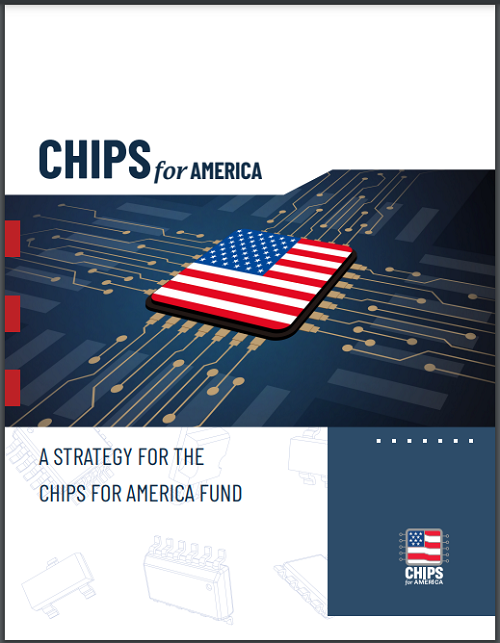The wheels are turning on the so-called CHIPS and Science Act, with a flurry of activity this week to turn the legislation into action.
On Friday, U.S. President Joe Biden will be in Ohio alongside Intel CEO Pat Gelsinger to break ground on the chipmaker’s new $20 billion manufacturing site, which will likely be partially funded by the U.S. government.
That comes after the U.S. Department of Commerce earlier this week laid down plans on how it will implement the U.S. Chips and Science Act, which was signed into law by Biden last month.

The CHIPS and Science Act is a way to reestablish the U.S. as a chip manufacturing powerhouse, which will strengthen the supply chain and open up high-tech jobs. The CHIPS and Science Act opens up close to $50 billion in incentives for companies like Intel to establish new factories.
The ongoing shortages of chips has affected industries like automotive and consumer electronics, and the CHIPS and Science Act aims to ensure a steady supply of indigenous chips. The U.S. government also wants to weaponize semiconductors for geopolitical purposes through steps like banning AI chip shipments to China and shutting down semiconductor supplies to Russia.
The recommendations on how to deploy the CHIPS and Science Act funds were partially based on recommendations provided by the President’s Council of Advisors on Science and Technology (PCAST), which includes AMD CEO Lisa Su and Nvidia Chief Scientist Bill Dally (co-leads of the PCAST semiconductor working group).
Of the $50 billion in funding $39 billion will be available to applicants to invest in facilities and equipment for the design, validation, testing, packaging and manufacturing of chips. The funds may be available as loans, grants or public-private joint ventures.

The remaining $11 billion will be headed to the National Institutes of Standards and Technology for chip research and development programs. NIST will dedicate a portion of that amount to establishing the National Semiconductor Technology Center (NSTC), which provides funds and the means for the research and development of advanced chips. NIST will also establish the National Advanced Packaging Manufacturing Program (NAPMP), aimed at creating a robust domestic advanced packaging capacity. A third R&D initiative would set up Manufacturing USA institutes to advance chip manufacturing and materials development.
NSTC could become the focal point for U.S. agencies to test their technologies, Su said during a PCAST meeting that was webcast this week.

“We can imagine the Department of Defense or DARPA – there might be opportunities for some of their programs to actually use the NSTC facilities…[as] part of the overall capability of the nation,” Su said.
The funding in the CHIPS and Science Act has been criticized as a waste of taxpayer money in the form of corporate giveaways. “The CHIPS program will include rigorous review of applications along with robust compliance and accountability requirements to ensure taxpayer funds are protected and spent wisely,” the plan states.
Applicants will receive funding for factories on U.S. soil, and it cannot “support facilities being constructed or operated abroad,” according to the plan. That’s a problem for companies like Intel, which does chip manufacturing in the U.S. and testing and assembly at plants in China.

The CHIPS and Science Act is broken down into three major initiatives.
The first initiative opens up close to $28 billion in funding for leading-edge nodes on which advanced chips are made. This funding may go to only a handful of companies that have pledged to establish advanced factories in the U.S.
Intel’s megafab, which is expected to open in 2025, is expected to be on smaller and energy efficient transistors patched together with advanced packaging. TSMC, which is based in Taiwan, and Korea-based Samsung have pledged to build advanced chip factories on U.S. soil.
 Additionally, close to $10 billion will be available to “mature” nodes, which are based on older technology, but are equally critical for anything with an on/off switch. A report by the U.S. Department of Commerce in January identified a shortage of chips such as microcontrollers made on nodes starting at 40nm disrupting the production of cars, medical devices and other electronics. For example, the shortage of power-management controller disrupted the production of electric cars.
Additionally, close to $10 billion will be available to “mature” nodes, which are based on older technology, but are equally critical for anything with an on/off switch. A report by the U.S. Department of Commerce in January identified a shortage of chips such as microcontrollers made on nodes starting at 40nm disrupting the production of cars, medical devices and other electronics. For example, the shortage of power-management controller disrupted the production of electric cars.

The U.S. Department of Commerce said it expects dozens of awards to be given. The funding could go to companies like Texas Instruments and GlobalFoundries, which are focusing primarily on mature nodes.
NIST will take on the remaining funding of about $11 billion to establish research and development programs in assembly, packaging, advanced nodes, materials and chip development technologies. NIST will also invest in workforce development programs.
The PCAST group specifically identified workforce development as a critical piece in advancing the semiconductor ecosystem. The recommendation included 2,500 scholarships and assistantships per year, and drawing talent from around the world.
“There’s a real need to recruit the most talented people in semiconductors from around the world. To that end, we are recommending the Department of Homeland Security implement existing statutory measures to accelerate the processing of immigrant petitions from people who work in this area,” Nvidia’s Dally said in the PCAST meeting this week.




























































